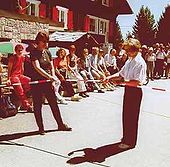Unterbäch
| Unterbäch | |
|---|---|
| State : |
|
| Canton : |
|
| District : | West Raron |
| BFS no. : | 6201 |
| Postal code : | 3944 |
| Coordinates : | 627.85 thousand / 126 018 |
| Height : | 1193 m above sea level M. |
| Height range : | 637-3050 m above sea level M. |
| Area : | 22.08 km² |
| Residents: | 436 (December 31, 2018) |
| Population density : | 20 inhabitants per km² |
| Website: | www.unterbaech.ch |
|
Unterbäch |
|
| Location of the municipality | |
Unterbäch ( Valais German : Unnerbäch ) is a political municipality and a civic community in the Westlich Raron district and a parish of the Raron deanery in the German-speaking part of the canton of Valais (Upper Valais) in Switzerland .
geography
The village is located in the Valais Alps on a southern high plateau above the Rhone Valley , on the so-called Schattenberge, which despite its name is one of the sunniest and most beautiful areas in Switzerland. The community emerged from several hamlets in 1290, and its first statutes were drawn up in 1490. In 1554, with special papal permission, Unterbäch founded its own parish ; its parish church was built in 1558. Since 1957, a historic referendum in the village, Unterbäch has been known as the “ Rütli of the Swiss woman”.
population
| Population development | ||||||||||
|---|---|---|---|---|---|---|---|---|---|---|
| year | 1798 | 1850 | 1900 | 1950 | 2000 | 2010 | 2012 | 2014 | 2016 | 2019 |
| Residents | 238 | 228 | 385 | 415 | 426 | 401 | 409 | 404 | 412 | 469 |
Rütli the Swiss woman
Unterbäch is also called the “Rütli of the Swiss Woman” because on March 3, 1957, the first Swiss vote with women took place there. The local council at the time had decided to let women take part in a federal ballot on the extension of the civil protection obligation to women (the proposal was rejected across Switzerland with 52 percent votes against).
Katharina Zenhäusern (1919–2014) was the first ever Swiss woman to put a voting card in a Swiss ballot box. Her husband, mayor and councilor Paul Zenhäusern (1917–2002), and the Valais National Councilor Peter von Roten (1916–1991) were the initiators of women's participation. The media march was huge, also reporters from Der Spiegel and the New York Times reported on the location of the event, as well as the Swiss Film Weekly in its contribution of March 8, 1957.
In the now famous vote, 33 of the 84 women potentially eligible to vote took part. Their votes, which were collected in a separate ballot box (the men's votes remained so valid), were canceled, however, as women's participation at that time had no legal basis. Nevertheless, this first federal women's vote gave an important impetus for the later official introduction of women's suffrage. As early as 1957, Unterbäch was the first municipality in Switzerland to introduce municipal voting rights for women - despite a ban by the Valais State Council .
Honorary citizen and women's monument
Elisabeth Kopp , the first female federal councilor in Switzerland, became an honorary citizen of the Unterbäch municipality after her election to the state government in 1984 . In 1985 she inaugurated the Unterbacher memorial sculpture in front of the Burgerhaus (community center), which is dedicated to the historical women's vote and the first female Federal Councilor.
The robust, aesthetic bronze monument by the Valais artist Andreas Henzen from Visp represents the Unterbach symbol, a double cross , in the middle of a sweeping, slightly spiral-shaped and ever wider band. The sculpture, which also resembles a sundial , could represent the fulfilled time of Swiss women, as expressed by the embossed dedication on the broadest part of the bronze ribbon with words: "In 1957, women went to the ballot box in Unterbäch for the first time since the Confederation was founded - Switzerland's first Federal Councilor, Unterbäch's honorary citizen Ms. Elisabeth Kopp, unveiled this commemorative work on August 18, 1985, the day of their Ehrenburg celebration. "
Women's quotation path
The 3.5 km long hiking trail from Unterbäch to Brandalp has been called the Frauen-Zitatenweg since 2000 . At that time, the path was marked with twelve large plaques bearing quotes from world-famous women. The decorative background images of the quotation board were designed by the Valais graphic designer Denis Eyer-Oggier , Naters .
Mayor
At the beginning of 2009 a woman was elected to lead the community for the first time: Rosa Weissen-Zenhäusern, daughter of Maria Elsig and Leo Zenhäusern, who supported the historic women's vote of 1957 (see Rütli of the Swiss woman ).
Personalities
- Sigismund Furrer (1788–1865), historiographer of the Valais and provincial of the Swiss Capuchins
- Elisabeth Kopp (* 1936), First Federal Councilor in Switzerland, honorary citizen of the Unterbäch community since 1985.
- Katharina Zenhäusern (1919–2014), the first woman ever to put a voting card in a Swiss ballot box
Historic parish church
In 1551, Unterbäch received from Pope Julius III. the privilege of founding one's own parish , a facsimile of the papal bull is on display in the Unterbacher Church. The church was founded in 1554 by the then Bishop of Sitten Johann Jordan , the parish also included the residents of the neighboring village of Bürchen . The common single-nave parish church " Heilige Dreifaltigkeit " along the Unterbacher Dorfstrasse was built in the late Gothic style in 1556–1558 and consecrated by the bishop in 1558, the remains of frescoes and the tabernacle on the choir wall date from this time . In 1675 the church was enlarged, rebuilt in the 18th century and renovated in 1937. The wooden sculptures are masterpieces by the Valais sculptor and altar builder Johann Ritz , high altar with the coronation of Mary and crucifixion group on the choir arch from 1697, and (probably) Peter Lagger , side altars from around 1750. The canopy pulpit was built around 1710 by the Unterbacher Kalbermatten family. An unknown master built the historical organ on the gallery around 1700 , which is framed with wing paintings. The earthquake of 1855 caused a crack in the vault of the church that had to be renovated. Two former church bells can be seen at the fountain in the church square, the baroque “ midday bell ” from 1560 and the rococo “ Evangeli or Kapetsch bell ” from 1784. The municipality of Bürchen founded its own Catholic parish in 1879 and left the parish association. The Unterbach parish church is under federal monument protection.
From Don Bosco Park and
More Attractions
literature
- Alois Grichting: Unterbäch. In: Historical Lexicon of Switzerland . 2012 .
- Gregor Zenhäusern: Wood. In: Historical Lexicon of Switzerland . 2008 .
- Lundwig Weissen: Memories from Unterbäch. Saint-Maurice 1959
- Pastor Josef Indermitte: Chronicle of the community of Unterbäch. Visp 1986
- Historical-Biographical Lexicon of Switzerland. Volume 7, Neuchâtel 1934
- Swiss lexicon in twelve volumes, popular edition. Volume 11, Verlag Schweizer Lexikon Mengis + Ziehr, Visp 1999, ISBN 978-3-9520144-1-7
Web links
- Unterbäch on the ETHorama platform
- Unterbäch - Official website of the municipality
- Official WebGIS of the community of Unterbäch
- Unterbäch - municipal coat of arms
Individual evidence
- ↑ Permanent and non-permanent resident population by year, canton, district, municipality, population type and gender (permanent resident population). In: bfs. admin.ch . Federal Statistical Office (FSO), August 31, 2019, accessed on December 22, 2019 .
- ^ Daniel Meier: The first Swiss woman at the urn. Obituary in: NZZ am Sonntag . from June 1, 2014, p. 19.
- ↑ Switzerland / Women's Suffrage: Progress in Unterbäch . In: Der Spiegel . tape March 11 , 1957 ( spiegel.de [accessed March 29, 2018]).
- ↑ The right to vote for women in Unterbäch Swiss Film Weekly from March 8, 1957
- ↑ Der Frauen-Zitatenweg ( Memento of the original from September 29, 2007 in the Internet Archive ) Info: The archive link was inserted automatically and has not yet been checked. Please check the original and archive link according to the instructions and then remove this notice. , Opening on June 18, 2000 by Elisabeth Kopp and Brigitte Hauser, then president of the Zukunft-Frau association
- ↑ Today, Unterbäch is in the hands of women. In: St.Galler Tagblatt Online . February 5, 2009.
- ↑ Otto Volger: Investigations into the phenomenon of earthquakes in Switzerland . tape 2 . Justus Perthes, Gotha 1857, p. 101 ( limited preview in Google Book search).



















